Source: CCTV.com
08-15-2006 14:06
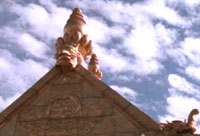 | |
Erected in the seventh century, the Potala Palace was damaged by lightning and afterwards almost entirely destroyed in the times of Landarma who was a bitter opponent of Tibetan Buddhism. But in the 17th century under the Fifth Dalai Lama, the palace was restored to its original form.
Pilgrims perform their duty in various ways. For example, they repeatedly bow their upper bodies until their heads touch the ground or their bodies lie flat on the ground, prostrating. Another well-known ritual is to spin prayer wheels, which range from handheld units that are common souvenirs, to huge ones that stand several meters high. Another practice is to contribute yak butter, which is used to light the oil lamps in temples and monasteries. Another donation pilgrims make is money. They simply put the coins or small notes everywhere, especially near the Buddha statues, and the money is not frequently collected.
 | |
With its majestic splendor, the Potala Palace would impress the inhabitants of any world capital. Thus the humble Tibetan pilgrim, who has always lived in a yak hair tent, must view the Potala Palace with great reverence. It is amazing to experience that this 13-storey structure containing 999 rooms, which was built on a steep mountain in Lhasa.
Unlike the majority of the famous architectural wonders of China, the Potala Palace is built on a vertical flat. The palace dominates the city, in fact it dominates the entire Tibet and captures one's attention immediately. Its walls are slanted like the sides of a condensed Great Wall, seeming to reproduce the outline of mountain slopes.
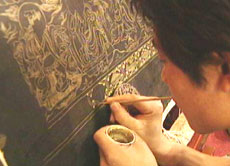 | |
There is indisputable evidence to prove that the ethnic roots of different cultures had become interwoven long ago. In the oldest part of the Potala Palace, the Prayer Cave Vault, you can see the statues of the Tibetan King Songtsan Gampo (629-650) and his wife, the Tang Dynasty Princess Wen Cheng.
During the Tang Dynasty the Chinese capital Changan (today's Xian) was one of the centers of world civilization, as it was the starting point of the "Silk Road" to Central Asia, the Middle East and Europe. So it is not surprising that Princess Wen Cheng brought along many scholars and craftsmen who laid the basis for many crafts and trades in Tibet.
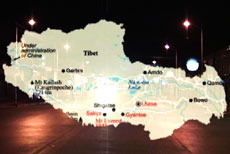 | |
Situated right in the center of old town Lhasa, the Jokhang Temple boasts of a history of more than 1,350 years. Legends have it that the construction of the temple took King Songtsen Gampo, and Princess Wencheng three years to complete. Because the original site of the temple had been a lake, the princess had to have white goats to carry soil from elsewhere to fill the lake up.
At first, the Jokhang Temple was called "Resa" and later was called "Jokhang" to mean "Buddhist chapel" in the Tibetan language. "Resa" in Tibetan means soil and goats to indicate that the temple was built with the soil carried to the site by white goats. However, there is another saying about the name of the temple. It is said that the new name has something to do with the Monlam Festival created by Tsongkapa in the 15th century.
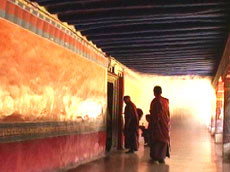 | |
The Jokhang Temple, first built in the shape of a two-story boat. It is the most magnificent building remaining from the Tupo Dynasty in Tibet. After being refitted and enlarged by the subsequent dynasties, it now covers an area of more than 25,100 square meters.
Inside the temple there are several chapels. The Jokhang Temple is the main chapel that is in the shape of a courtyard. Behind hundreds of yak-butter lamps, there is the main prayer hall, which houses the statue of Avalokitesvara with eleven faces and 1,000 arms and one thousand eyes on hand palms.
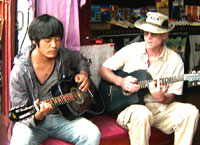 | |
The chapel housing the statue of Songtsen Gampo, who is deemed as the religious king in Tibet, is found on the second floor of the temple. The third floor is a place for monks and lamas to retreat and is seldom open to visitors or pilgrims.
Barkhor Street is an open market street circulating Jokhang Temple. Usually souvenirs are sold during the day, while at twilight, daily necessities seem to dominate the market. And believe it or not, you can easily access the Internet in at least one of the cafes and find a French cuisine or Nepalese restaurant on Barkhor.
I was told that Barkhor was the original layout of Lhasa in just 20 years ago. Everything we see today is a result of very recent development of the city. Most of it is for tourists.
 | |
Thanka paintings are a universal feature of temples and monasteries in Tibet. There are over 200 in Jokhang Monastery alone, covering an area of 300 square meters. The painters followed strict rules. For instance, the Buddha must be solemn, and his body must be portrayed in certain specific proportions. Historical and folklore themes thrive in murals.
Religion is very important to the Tibetans with everything being centered around it, along with education cultural was based on religious beliefs.
Probably Buddhism was first introduced to Tibet in 173 CE during the region of the 28th Yarlung King Thothori.
 | |
Dharma Wheel symbolizes the unity of all things, spiritual law and Sakyamuni himself. The wheel is usually flanked by two deer, the first to listen to Sakyamuni's teachings. The male deer symbolizes the realization of great bliss while the female deer symbolizes the realization of emptiness.
Lamas are the teachers of Buddhism. Lama plays an important role in Tibetan Buddhism. Lama teaches all the monks and takes care of the system of Buddhism making sure it continues to work. In 1578 the Lama Sonam received the title of Ta-Le (Dalai) from the Mongolian ruler Atlan khan. Because he wad the third reincarnation found in a row he became the third Dalai Lama.
About 100 kilometers north from the capital Lhasa is Nianqingdanggula Mountain. The mountain is more than 7,000 meters high and is covered with snow all year round.
 | |
Namco Lake is located on the Northwestern side of the Niangqing danggula peak. The highest point is 5,200 meters. Namco means "Heavenly Lake" in Tibetan. It is a famous Holy place of Tibetan Buddhism. Driving from Lhasa will take about 5 hours depends on the road condition. Visitors can spend a night at the site living in one of the tourist tents. However, due to the lack of oxygen over the night, visitors should consider bring extra oxygen tank.
There are five highways stretching into Tibet. Sichuan-Tibet Highway is the longest, 2413 kilometers (1496 miles) long, built in 1950 and opened for traffic in 1954. The road climbs up and down 14 high mountains which average altitude is 4000-5000 meters (13120-16400 feet) high, and flies over a dozen of famous rivers such as Lantsang River (Mekong). The climate along the road presents beautiful scenery ranging from spring to winter. However, the road condition is various.
Paying Homage to the Holy Mountain Festival, Choekhor Duechcen in Tibetan, falling on 4th of the 6th Tibetan month, is to commemorate Sakyamuni's first sermon. People, in their best conduct during the session, go to monasteries to pay homage to the Buddha. Circumambulation around mountains is the popular practice in the festival. Picnicking, singing and dancing are also part of the activities.
Editor:Chen Minji

